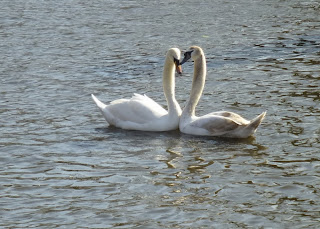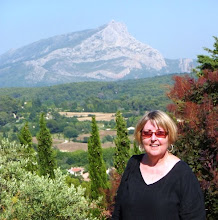This one in Bruges was founded in the late 13th century, although the date over the gate is from 1776. The dates of the houses built around the courtyard in typical Beguinage style vary, but many are quite old, some going back to the 15th century.
Our timing was perfect. We got there just as the daffodils were in bloom. We met someone who told us that only lasts for 2 weeks each spring. There were lots of people there because of the blooming, but it wasn't crowded at all.
If you see anyone out in the middle of the daffodils, they are not supposed to be there.
We went into the small chapel and got there just in time for Evensong. There weren't many nuns (the Begijnhof became a monastery for the Benedictine order in 1937), but they sang well in this lovely little chapel. The original 13th century church burned in the late 16th century, was rebuilt around 1609 and later remodeled in the baroque style. At least the interior was. The exterior is still a simple 17th century church.
After the service, the nuns headed back for dinner, at least that's my guess.
Except for one that you can see just to the left of the entrance door to the church. She's tiny, so you need to click on the picture to see her better.
She was paused there to tell these people to get out of the daffodils. When they didn't move, she got a little more aggressive about telling them.
Trout did take a picture of me at the entrance. Please note that I am not standing in the daffodils. I read the signs.
Here you can see someone behind me not following the rules.
We ran into a couple who wanted their picture taken. Fortunately, they had the same camera as I did, so we swapped cameras and took each other's pictures. I think their pictures of us turned out better than my pictures of them. If I remember correctly, they spoke French.
This is another similar facility, but with no religious folk and totally for people of limited means.
Started as early as the 14th century rich families and corporations of Flemish cities built houses for poor and needy widows and widowers. This one is one of the most lovely, Godshuis de Meulenaere, from 1613.
The inhabitants created little gardens in the courtyard and got their water there. Even today, most Godshuizen are occupied by elderly people. They are now run by the Bruges Department of Social Care. The occupants get food and basic care, just like when they were established. The names of the Godshuizen are based on the benefactor and the year built. There are several in the city.
It is perfectly okay to go through the gate to see the inside, like we did.
Seeing these places, literally only a couple of blocks away from the Halve Maan, was a nice respite from the rest of the well-populated Bruges streets.













































































